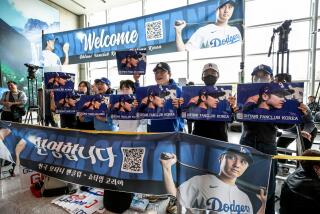A trip to Japan with my teenage nephew leads to life lessons
“You know,” Mike, my brother-in-law, said to me when his son Matthew, was born, “when he’s 16 you’re taking him to Japan.”
“That sounds cool,” I said, thinking to myself “Yeah, that‘ll happen.”
But Mike is pretty persistent, and 16 years later Matthew (now Matt) and I were on a plane to Tokyo.
Our 10-day trip turned out to be full of surprises and an education for us both: Matt learning about the country, me learning how to travel with a teenager, and for the both of us, an unparalleled bonding opportunity.
A little background: Our family is not Japanese but I lived in Japan in the 1980s, learned the language, did a master’s concentration in East Asian studies and have worked with Japanese companies as an employee and a consultant ever since. I have also written several guidebooks about Japan and lead tours there. So bringing Matt here was not a random idea.
Nor was Mike’s motivation. When he was 16, his aunt took him on a camping trip, leaving him with a deep bond with her and a lifelong love of the outdoors.
Here’s how we worked the practicalities: I paid my own way, and Mike and my sister, Renée, paid for Matt. We traveled coach and stayed in inexpensive hotels — he can travel first class when he earns his own money — saving our splurges for experiences. We also saved a bundle by buying a one-week Japan Rail Pass.
Ninja know-how
Our first morning in Tokyo began with one of those splurges, a class in ninjutsu, or ninja skills, taught by descendants of actual ninjas. At about $150 each, it was a one-of-a-kind experience learning to slink silently like cats, shoot blow darts and throw shuriken (throwing stars), inspired by the spirituality that underlies the ninja way.
Later, Matt marveled at the vastness and bustle of the Tsukiji Fish Market — and was grimly fascinated watching a live eel being disemboweled. (The fish market has since closed and its operations have moved to the new Toyosu Market across the bay. Unlike at Tsukiji Market, access to the wholesale fish floor is restricted to specialized tours.
We also checked out some classic Tokyo experiences: Meiji Shrine, one of the grandest sites in the Shinto religion; Sensoji Buddhist Temple; a baseball game at the hulking Tokyo Dome; contemporary architecture; ramen and more eel (this time for eating).
Surprise No. 1: At pretty much every opportunity Matt was on Snapchat, he said to maintain a 120-day streak with his friends. (This is a thing, he said.) Meanwhile, I worried he might be more interested in Snapchat than in Tokyo. So on about Day 3, I sat him down and said, “Let’s review. What have we learned so far?”
Surprise No. 2: He expounded on ninjutsu chapter and verse, explained the differences between Shinto and Buddhism and how the architecture we saw on Day 1 related to other buildings we saw on Day 3. Plus, he recounted every detail of every meal. After that, I knew we would be OK.
On Day 4, I let him practice navigation skills to get us by subway to Tokyo Station and the Shinkansen bullet train, the first leg of our hiking trip in the Japan Alps. There we followed the Nakasendo Trail, the mountainous, centuries-old path through central Japan used by nobles between their home provinces and the capital.
After Tokyo, the pleasures of the country were simple and welcome: taking pictures in the photogenically preserved, 150-year-old village of Tsumago, and happening on a secluded waterfall and an old farmhouse where the owner invited us in to cool off with chilled cucumbers dusted with salt.
We spent the night in Tsumago at a rustic, 1800s-vintage ryokan (traditional inn), where we ate dinner dressed in yukata (blue-and-white cotton robes), slept on futons on tatami mat floors and used the inn’s communal baths.
I sheepishly realized I had neglected to educate Matt on Japanese bathing etiquette: You wear your yukata to and from the baths instead of walking around, as he did, with a towel around your waist as if in a locker room. This is not done at a ryokan, no matter how buff you are.
In the nearby city of Matsumoto, a kindly retiree volunteer guide showed us around one of the country’s four remaining original castles, and I couldn’t have been prouder of how engaged Matt was learning about Japan’s feudal history.
Our last several nights were in Kyoto, where we visited the Golden Pavilion of Kinkakuji Temple, attended a tea ceremony and had to seek shelter under an overhang for 25 minutes when a sudden storm deluged the paved path through 10,000 orange Shinto torii gates of the Fushimi Inari Shrine — that entire sequence went on Snapchat, naturally. Along the way we swapped stories about family lore and the trials of 21st century teendom.
Heading west
Kyoto also was our base for exploring western Japan. Matt was old enough to appreciate the tragedy at Hiroshima (he had studied World War II in school), yet young enough to be enchanted by deer roaming freely on nearby Miyajima, the island known for the red torii gate that appears to float just offshore. (The gate closed this month for what may be a year-long renovation.)
Another day trip took us to Kobe and another splurge: a $100 Kobe beef dinner. Mike was not happy when he heard about this, but Renée prevailed on him to let it go. After all, when was that opportunity going to come again?
At the end of our 10 days, our rail passes took us back to Narita airport for our flight home.
If Matt learned lessons on our trip, so did I. Among them:
1. Plan, but don’t overplan. Downtime can be as important as active time. Sometimes serendipitous discoveries turn out to be the most memorable, such as the deer on Miyajima and the eel in the fish market.
Then there was the bonding moment in a clothing shop where a photo of me in a black-and-white checkered romphim might become blackmail material one day. Plus, you need time for processing what you’ve seen, not to mention sharing on social media.
Exploring the birthplace of Bauhaus, a German movement that changed design »
2. Book separate rooms. Rooms in Japanese budget hotels are cramped, and I figured being together 24/7 would be too much, especially with jet lag.
I was all the more grateful for our separate rooms after beholding the tsunami-style swirl of clothes, electronics and souvenirs piled on the floor of Matt’s room. Evidently this is his way of unpacking. I had to banish thoughts of Marie Kondo from my mind.
3. Gifts are good. During one of our random conversations, Matt opined that he didn’t like dressing up, which prompted a life lesson from Uncle Andy about the importance of looking marvelous. So I proposed a ritual his Pop Pop (Renée’s and my dad) still likes to do with me: clothes shopping when we’re on the road together.
I didn’t think it sank in until, a couple of days later, I was trying on some duds at one of my favorite Japanese retailers. I exited the fitting room to find him standing there with a stack of clothes and asking if he could try them on. I (and later Pop Pop) were delirious with pleasure. And after Matt returned home he got an after-school job at Old Navy.
4. You never know what will stick. My sister tells me that nearly two years after our trip, every so often Matt will randomly mention something about his experiences in Japan. He even included our trip in his college application essays.
Best of all, he told his younger sister all about it, and I’m taking her to Japan this summer, when she will be 16.
If you go
THE BEST WAY TO TOKYO
From LAX, JAL, All Nippon, American, United and Singapore offer nonstop service to Tokyo, and Air Canada, Asiana, Cathay Pacific, Hawaiian, Korean, Malaysian, Singapore, United and Delta offer connecting service (change of planes). Restricted round-trip airfare from $1,031, including taxes and fees.
WHERE TO STAY
Bargain-priced “business hotels” such as the Toyoko Inn group feature small single or twin rooms and include a simple breakfast. Somewhat pricier chains such as Villa Fontaine and Richmond offer larger, more stylish rooms.
WHERE TO EAT
Inexpensive restaurant chains such as Ootoya and Nakau have a nationwide presence and serve complete meals for about $10. as do ramen chains such as Ichiran and Ippudo. Inexpensive noodle and conveyor-belt sushi shops are plentiful, quick and fun.
TO LEARN MORE
Japan National Tourism Organization
More to Read
Sign up for The Wild
We’ll help you find the best places to hike, bike and run, as well as the perfect silent spots for meditation and yoga.
You may occasionally receive promotional content from the Los Angeles Times.






